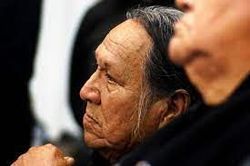Chief Crow Dog was born on the Rosebud Indian Reservation in South Dakota to a Sičháŋǧu Lakȟóta family strong in its traditional heritage of Medicine Men and leaders--his great-grandfather, Jerome Crow Dog, who was the first Native American to win a Supreme Court Case (ex parte Crow Dog), had been a Ghost Dancer who is credited with receiving a vision that led him to warn other Ghost Dancers to stay away from large gatherings. This admonition saved many from being victims at the Wounded Knee Massacre. Because his parents knew he would be a healer, they did not send him to public school. As a result, he did not grow up able to read or write English. He ventured on his first Haŋblečeya when he was thirteen years old.
Chief Crow Dog was an influential guide for the American Indian Movement, and his moral and political priorities shaped the Native American Self-Determination and Education Act. He was part of the Trail of Broken Treaties cross-country caravan and the takeover of the BIA headquarters in Washington DC.
After the Wounded Knee standoff of 1973, the federal government began seeking out AIM leaders, arresting them on a variety of charges. In September, 1975, the FBI and US Marshals, along with SWAT teams, descended upon Crow Dog's Paradise, looking for Leonard Peltier. Chief Crow Dog was arrested, charged, convicted, and incarcerated. The National Council of Churches became involved, raising money for his appeal. Attorney Vine Deloria Jr. was one of the attorneys working on his behalf. His appeal was denied, but attorneys then asked for a sentence reduction, which was granted. He had served just shy of two years.
Chief Crow Dog paticipated in the 1978 "Longest Walk" and 1980's "Long Walk for Survival."
Chief Crow Dog married his first wife, Francine, in the Native American Church. At that time, he adopted the name "Defends His Medicine," referring to the ceremonially and spiritually important peyote plant. His second marriage, to Mary Ellen (later known as Brave Bird), began shortly after Wounded Knee. They lived at Crow Dog's Paradise, with his children and her son.
Chief Crow Dog wrote "Crow Dog: Four Generations of Sioux Medicine Men," a memoir of his family history.
Beyond all of this, Chief Crow Dog was a man who loved, who guided, who shared and joined together. His was a proud tradition and he was a teacher, a leader, and a friend to the world. He will be missed.
Chief Crow Dog was born on the Rosebud Indian Reservation in South Dakota to a Sičháŋǧu Lakȟóta family strong in its traditional heritage of Medicine Men and leaders--his great-grandfather, Jerome Crow Dog, who was the first Native American to win a Supreme Court Case (ex parte Crow Dog), had been a Ghost Dancer who is credited with receiving a vision that led him to warn other Ghost Dancers to stay away from large gatherings. This admonition saved many from being victims at the Wounded Knee Massacre. Because his parents knew he would be a healer, they did not send him to public school. As a result, he did not grow up able to read or write English. He ventured on his first Haŋblečeya when he was thirteen years old.
Chief Crow Dog was an influential guide for the American Indian Movement, and his moral and political priorities shaped the Native American Self-Determination and Education Act. He was part of the Trail of Broken Treaties cross-country caravan and the takeover of the BIA headquarters in Washington DC.
After the Wounded Knee standoff of 1973, the federal government began seeking out AIM leaders, arresting them on a variety of charges. In September, 1975, the FBI and US Marshals, along with SWAT teams, descended upon Crow Dog's Paradise, looking for Leonard Peltier. Chief Crow Dog was arrested, charged, convicted, and incarcerated. The National Council of Churches became involved, raising money for his appeal. Attorney Vine Deloria Jr. was one of the attorneys working on his behalf. His appeal was denied, but attorneys then asked for a sentence reduction, which was granted. He had served just shy of two years.
Chief Crow Dog paticipated in the 1978 "Longest Walk" and 1980's "Long Walk for Survival."
Chief Crow Dog married his first wife, Francine, in the Native American Church. At that time, he adopted the name "Defends His Medicine," referring to the ceremonially and spiritually important peyote plant. His second marriage, to Mary Ellen (later known as Brave Bird), began shortly after Wounded Knee. They lived at Crow Dog's Paradise, with his children and her son.
Chief Crow Dog wrote "Crow Dog: Four Generations of Sioux Medicine Men," a memoir of his family history.
Beyond all of this, Chief Crow Dog was a man who loved, who guided, who shared and joined together. His was a proud tradition and he was a teacher, a leader, and a friend to the world. He will be missed.
Family Members
Sponsored by Ancestry
Advertisement
Records on Ancestry
Advertisement








